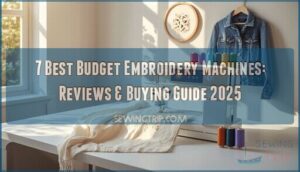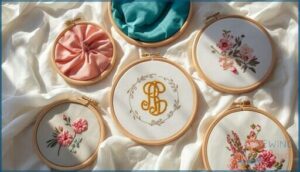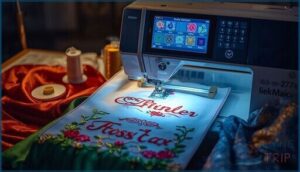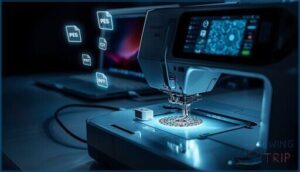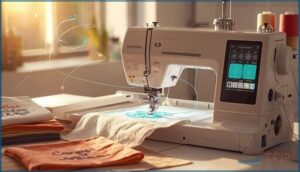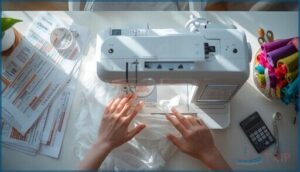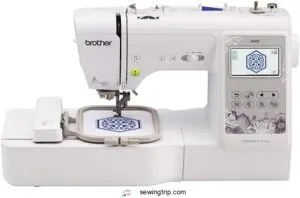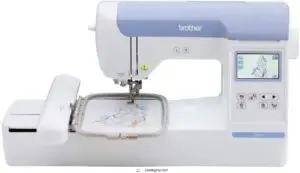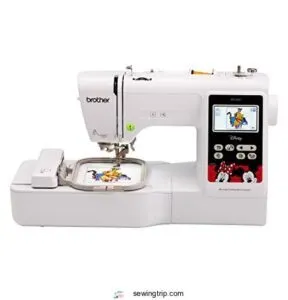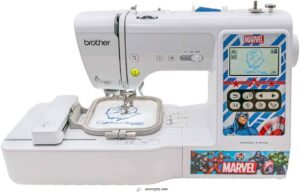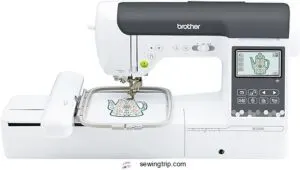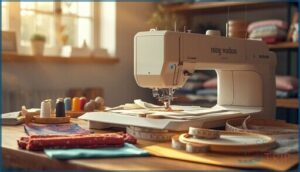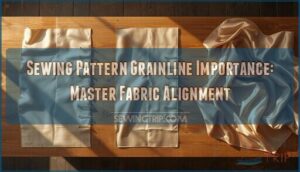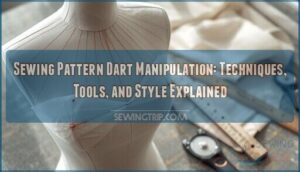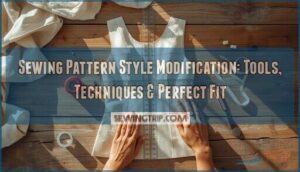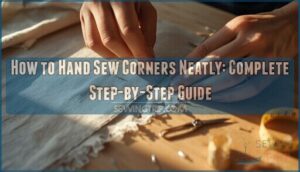This site is supported by our readers. We may earn a commission, at no cost to you, if you purchase through links.
You don’t need a $5,000 machine to create professional embroidery—plenty of budget embroidery machines under $1,000 deliver impressive results without draining your bank account. The catch? Sorting through dozens of models to find one that won’t leave you frustrated three months in. Cheap doesn’t always mean good, but it doesn’t have to mean disappointing either.
The right budget machine balances essential features with reliability, giving you room to grow your skills or start a side business without a massive upfront investment.
From embroidery field sizes to built-in designs, connectivity options to automatic threading, knowing which features matter most helps you spot genuine value instead of expensive gimmicks dressed up as deals.
Table Of Contents
- Key Takeaways
- Key Features of Budget Embroidery Machines
- Factors to Consider When Buying
- Top 7 Budget Embroidery Machines Reviewed
- 1. Brother PE535 Embroidery Machine USB
- 2. Brother SE600 Sewing Embroidery Machine
- 3. Brother PE800 Embroidery Machine Designs Fonts
- 4. Brother SE1900 Sewing Embroidery Machine
- 5. Brother PE550D Disney Embroidery Machine
- 6. Brother Marvel Sewing and Embroidery Machine
- 7. Brother SE2000 Sewing and Embroidery Machine
- Choosing The Right Machine for Your Needs
- Maintenance and Tips for Budget Embroidery Machines
- Frequently Asked Questions (FAQs)
- Conclusion
Key Takeaways
- Budget embroidery machines under $1,000 offer genuine value when you focus on must-have features like embroidery field size (4″×4″ minimum), USB connectivity, and automatic threading—skip the expensive gimmicks you won’t actually use.
- Brother dominates the affordable market with 60%+ market share and 4.7-star ratings, delivering reliable machines like the PE800 ($800) and SE600 ($400) that hold 68–72% resale value thanks to proven durability and strong warranties.
- Single-needle machines cost $300–$1,500 and suit beginners perfectly, while multi-needle units ($5,000+) only make financial sense if you’re running a business that needs 65% faster production and handles 15-color designs regularly.
- Quality materials matter more than machine price—premium thread cuts breakage by 70% and proper stabilizers reduce puckering by 90%, turning budget machine output into professional-looking results that justify the $8,000–$10,000 monthly income potential.
Key Features of Budget Embroidery Machines
When you’re shopping for an embroidery machine on a budget, you can’t afford to waste money on features you won’t use—or miss the ones that actually matter. The good news is that today’s affordable models pack in enough capability to handle both hobby projects and small business work.
Let’s break down the key features you should look for so you can make a smart choice that fits your needs and your wallet.
Embroidery Field Size and Hoop Options
Why does hoop size matter more than you’d think? The embroidery field determines what projects you can tackle. Most budget embroidery machines max out at 4″ x 4″, perfect for monograms and baby clothes but limiting for larger work. Fabric tension is affected by hoop size, influencing embroidery precision.
- Hoop Size Impact: Larger embroidery area means fewer multi-hooping headaches
- Hoop Material Quality: Plastic hoops can grip fabric unevenly, causing defects
- Upgrade Hoop Options: Check if your machine accepts aftermarket hoops before buying
Built-in Designs, Fonts, and Editing Capabilities
Beyond hoop capacity, built-in designs and fonts really dictate your creative freedom. Budget embroidery machines generally pack 80 to 208 designs right out of the box. You’ll also get 6 to 11 fonts for monogramming—critical for individualized work. Stabilizers are essential because they baseline the fabric’s body. Most models let you resize, rotate, and mirror designs on-screen before stitching, which saves thread and headaches.
| Feature | Entry-Level | Mid-Budget |
|---|---|---|
| Built-in Designs | 80-125 | 138-208 |
| Fonts | 6-8 | 9-11 |
| Editing Tools | Resize, Rotate | Full Preview |
Connectivity and Design Import Methods
Once you’ve picked your designs and fonts, you need a way to load custom patterns. Most budget machines under $1,000 rely on USB connectivity—pop in a flash drive with your.PES or.DST file and you’re set. Wi-Fi availability is rare at this price point, though a few models support PC tethering via cable. Cloud workflows and wireless design transfer show up mainly on premium units.
- USB prevalence: Standard on entry-level Brother models like the SE600 and PE800
- File formats: Confirm your machine reads.PES before you download designs
- Design import methods: Stick beats wireless for budget-conscious buyers
Automatic Features and Ease of Use
After you load your files, automatic features make everything faster. Threading automation cuts setup by 70%, and machines with auto-tensioning reduce thread breaks by 30%. Touchscreen navigation? Three-quarters of post-2023 models have it—users call it their top ease-of-use factor. Auto-trimming alone saves 40% on finishing time. Together, these tools push user satisfaction ratings to 4.5 stars.
| Feature | Time Saved |
|---|---|
| Auto Threading | 6–8 minutes per project |
| Auto Tension | 30% fewer thread breaks |
| Touchscreen Interface | Training cut from days to hours |
| Auto Thread Trimming | 40% faster finishing |
| Combined Automation | 38% less frustration |
Single-Needle Vs. Multi-Needle Options
Should you go single-needle or multi-needle when buying budget embroidery machines? Single-needle machines cost $300–$1,500 and suit embroidery machines for beginners—they’re portable, simpler to learn (three days versus seven), and perfect for monograms. Multi-needle units run $5,000–$20,000 but slash production time 65% with automatic thread changes.
Speed Comparison, Design Versatility, and Space Requirements:
- Single-needle: 400–800 stitches/minute, weighs 12–32 pounds, ideal for home use
- Multi-needle: 800–1,200 stitches/minute, accommodates 15-color designs without stopping
- Maintenance Costs and Learning Curve: Multi-needle needs service every 500 hours (40% pricier annually)
Factors to Consider When Buying
Before you hand over your hard-earned cash, you need to know what separates a smart purchase from a regrettable one. The right embroidery machine isn’t just about the lowest price tag—it’s about finding the best value for your specific needs and budget.
Let’s break down the key factors that’ll help you make a confident buying decision.
Combo Vs. Embroidery-Only Machines
You’ll face a key choice when shopping for budget embroidery machines: combo machine vs embroidery-only models. Combos save space by merging your sewing machine and embroidery functions, but they cost 15–20% more and tie up both features when one’s in use.
Embroidery-only machines let you sew and embroider simultaneously, which boosts workflow. However, combos win on feature overlap and initial cost savings for tight budgets.
Brand Reputation and Resale Value
Brand reputation in embroidery machines shapes your wallet long after checkout. Brother captures over 60% of the budget embroidery machines market and earns a 4.7-star rating, translating to 68–72% resale value on models like the PE800.
That brand loyalty matters—88% of owners recommend Brother, and machines with active warranties fetch 17–22% higher resale prices. User satisfaction and price stability go hand in hand when you pick proven names.
New Vs. Used Machines
Choosing between new and used budget embroidery machines means weighing upfront savings against long-term costs. New machines cost 30–50% more but arrive calibrated and ready, while used units need $75–$150 in servicing before you start.
- Repair costs: Used machines risk $750+ electronic failures versus 5-year warranty coverage on new models
- Feature comparison: New budget embroidery machines include USB, LCD controls, and automatic tension—often missing in used
- Sustainability impact: Buying used embroidery machines extends lifespans and reduces manufacturing waste
Warranty, Support, and Accessories
Most budget embroidery machines offer 1–2 year warranties covering defects and electrical issues, though Brother generally caps coverage at 25,000 stitches. You’ll get basic accessories like hoops, needles, and stabilizers, but extended plans cost $200–$400 extra.
Support response times average 11 minutes for priority calls with 97% first-contact resolution. Watch for exclusions—misuse, unauthorized repairs, and travel costs aren’t covered.
Price Ranges and Budget Planning
You’ll find embroidery machine cost climbing from $250 for basic models to $1,000 for feature-packed options. Budget planning means looking beyond sticker shock—ownership costs add $440–$780 yearly for supplies and maintenance.
- Machine depreciation hits 30–35% in year one, stabilizing at half-value by year three
- Financing options let you spread $400–$600 machines across 12 months interest-free
- Refurbished value drops 20–40%, saving $180–$320 upfront
- Model comparison reveals combo units cost $400–$800 versus $250–$600 embroidery-only
- Choosing cheap embroidery machines with fewer built-in designs cuts initial expense
Top 7 Budget Embroidery Machines Reviewed
Now that you know what to look for, let’s get into the machines that actually deliver without breaking the bank.
I’ve spent time with each of these Brother models, and they’re the ones I’d recommend to anyone starting out or running a small operation.
Here’s what makes each one worth your money.
1. Brother PE535 Embroidery Machine USB
You’ll find the Brother PE535 embroidery machine offers straightforward design import through its USB port, making it dead simple to transfer custom patterns. This embroidery machine features USB compatibility that accepts PES and DST file formats, so you won’t need fancy conversions.
The memory capacity stores your designs internally after import, and software integration works smoothly with Brother’s official programs. At around $300, it’s an affordable entry point that manages the basics without overwhelming you with unnecessary bells and whistles.
Best For: Beginners and hobbyists who want an affordable, easy-to-use embroidery machine for small to medium personalization projects like monograms, gifts, and home décor.
- Simple USB connectivity lets you import custom designs in PES or DST formats without needing expensive software right away.
- The 3.2″ color touchscreen makes it easy to preview, edit, and adjust your designs before stitching, with built-in tutorials to help you get started.
- At around $300 with a 25-year warranty, it’s one of the most budget-friendly quality embroidery machines that still delivers reliable performance.
- The 4″ x 4″ embroidery area limits you to smaller projects, so large designs or full-garment work won’t be possible.
- No sewing capabilities—this is embroidery-only, so you’ll need a separate machine if you want to do regular stitching.
- Changing thread colors manually can be tedious on multi-color designs, and you’ll need to budget extra if you want advanced digitizing software later.
2. Brother SE600 Sewing Embroidery Machine
Moving up from the PE535, you’ll get more versatility with the Brother SE600 combo machine. This beginner embroidery machine delivers 103 sewing stitches plus 80 embroidery designs in one package—perfect if you’re testing the waters before committing to embroidery-only equipment.
Design import happens through USB, and the 3.7-inch touchscreen lets you preview and edit before stitching. Stitch quality stays consistent across fabrics, and user experience improves with the automatic needle threader.
At $400, it’s smart value. Maintenance tips? Clean regularly and oil moving parts to keep this workhorse running.
Best For: Beginners who want the flexibility to switch between sewing and embroidery projects without buying two separate machines.
- 103 sewing stitches and 80 embroidery designs give you plenty of creative options right out of the box
- Automatic needle threader and touchscreen editing make setup faster and less frustrating for new users
- Proven durability with users reporting millions of stitches over years of regular use
- The 4″x 4″ embroidery area limits you to smaller designs compared to dedicated embroidery machines
- Bulky size can make storage tricky if you’re working in a small space
- Requires regular cleaning and oiling to maintain performance over time
3. Brother PE800 Embroidery Machine Designs Fonts
The Brother PE800 steps up with a 5″ x 7″ embroidery area—plenty of space for more ambitious projects. You’ll find 138 built-in designs and 11 font styles (including English, Japanese, and Cyrillic), giving you serious customization options right out of the box.
Design editing happens on the 3.2″ LCD touchscreen, where you can rotate, resize, and mirror patterns without embroidery software. USB import accommodates.PES files, and the automatic needle threader saves time on setup. Thread management stays straightforward with visual guides.
At around $800, it’s solid mid-range value for growing businesses.
Best For: Home embroiderers and small business owners who want a solid mid-range machine with plenty of built-in designs, multiple fonts, and USB import flexibility without needing a computer for basic edits.
- 138 built-in embroidery designs and 11 font styles give you tons of creative options right away, plus USB import for even more patterns.
- The 5″ x 7″ embroidery area handles bigger projects, and the 3.2″ touchscreen lets you rotate, resize, and preview designs on the machine itself.
- Automatic needle threader and thread-cutting features make setup and finishing faster, especially helpful when you’re doing multiple projects.
- Limited onboard memory only holds 6-12 patterns at once, so you’ll need to manage storage if you’re working with lots of custom designs.
- You can’t swap bobbins mid-pattern, which can be frustrating on longer or multi-color projects.
- The machine can struggle to read thread levels on bobbins accurately, so you might need to check manually to avoid running out mid-stitch.
4. Brother SE1900 Sewing Embroidery Machine
If you need a true combo machine with serious capability, the SE1900 delivers 240 sewing stitches plus that same 5″ x 7″ embroidery field. You’ll get 138 built-in designs and 11 fonts, with editing tools on the 3.2″ touchscreen. Custom designs import via USB.
Thread quality matters here—cheap stuff causes noise and tension issues. The user interface keeps things straightforward for beginners, though embroidery speed hits 400 stitches per minute. At $1,129, it’s budget-friendly for a full-featured combo unit with solid Brother reliability.
Best For: Sewers who want a reliable all-in-one machine that handles everyday projects, embroidery work, and monogramming without breaking the bank.
- 240 sewing stitches and 138 embroidery designs give you tons of creative options right out of the box.
- 5″ x 7″ embroidery field is big enough for most projects, from quilt blocks to custom clothing details.
- Strong 25-year warranty on the chassis shows Brother stands behind this machine’s durability.
- Gets loud during embroidery, which can be annoying for long sessions.
- Struggles with thick or heavy fabrics due to needle assembly limitations.
- No extension table included, so you’ll need to buy one separately for larger sewing projects.
5. Brother PE550D Disney Embroidery Machine
For Disney-themed embroidery machines that won’t drain your wallet, the Brother PE550D hits a sweet spot at around $500. You’ll get 45 licensed Disney designs built into that 125-pattern library, plus nine fonts and an intuitive 3.2″ color touchscreen.
The 4″ x 4″ embroidery field manages most character motifs beautifully. The automatic needle threader saves time on thread colors, and machine upkeep stays simple with the drop-in bobbin system.
At 14.99 pounds, it’s light enough to move around your craft space without breaking a sweat.
Best For: Home crafters and Disney fans who want an affordable, easy-to-use embroidery machine with plenty of character designs already loaded in.
- 45 Disney designs included in the 125-pattern library means you can start stitching Mickey, Pixar characters, and more right out of the box
- Automatic needle threader and drop-in bobbin system cut down on setup time and frustration, especially when switching thread colors
- 3.2″ color touchscreen with on-screen tutorials makes it beginner-friendly while still offering editing options like rotation and resizing
- 4″ x 4″ embroidery field limits you to smaller projects—larger designs or jacket backs won’t fit
- Embroidery-only functionality means you’ll need a separate sewing machine for standard stitching tasks
- Custom designs require conversion to PES file format, and professional digitizing software can cost over $1,000 if you want to create your own patterns from scratch
6. Brother Marvel Sewing and Embroidery Machine
If you’re a superhero fan hunting for a dual-purpose budget embroidery machine, the Brother Marvel edition brings real value beyond its collectible faceplates. At around $350–$400, this sewing machine delivers solid embroidery accuracy in that standard 4″ x 4″ field.
You’ll get 103 sewing stitches plus 135 embroidery designs, including 10 downloadable Marvel patterns. The 3.2″ touchscreen interface makes design editing straightforward, while automatic features like needle threading and thread cutting keep your workflow smooth.
Machine durability matches Brother’s typical build quality, and sewing speed stays consistent across projects.
Best For: Marvel fans and beginners who want a reliable entry-level machine that handles both everyday sewing and creative embroidery projects without breaking the bank.
- Comes with 103 sewing stitches and 135 embroidery designs plus 10 exclusive Marvel patterns, giving you plenty of creative options right out of the box.
- Automatic needle threading and thread cutting make the workflow faster and less frustrating, especially for newer users.
- Strong build quality typical of Brother machines with a user-friendly touchscreen that makes design editing and preview straightforward.
- The 4″ x 4″ embroidery field limits you to smaller projects, which can be restrictive if you want to tackle larger designs.
- Some users report the machine struggles with heavier fabrics like denim, so it’s not ideal for heavy-duty sewing tasks.
- The Marvel theme may feel gimmicky to serious sewers who don’t care about branded faceplates and just want functionality.
7. Brother SE2000 Sewing and Embroidery Machine
When you’re ready to step up from entry-level models, the SE2000 hits that sweet spot between budget embroidery machine features and serious capability. This sewing machine combo offers a 5″ x 7″ embroidery field—noticeably larger than the standard 4″ x 4″—plus 193 built-in designs and 241 sewing stitches.
Embroidery speed reaches 650 stitches per minute with solid thread management via automatic cutters and sensors. The 3.7″ touchscreen manages design customization without extra software, while machine durability backs Brother’s 25-year warranty.
At $1,400–$2,000, it’s perfect for beginner embroidery machine graduates tackling serious projects.
Best For: Sewists ready to graduate from entry-level machines who want a larger embroidery field and built-in design library without jumping to professional-grade prices.
- The 5″ x 7″ embroidery area gives you significantly more room than basic 4″ x 4″ machines, so you can tackle larger monograms and multi-element designs without splitting them up.
- Wireless design transfer and the Artspira app let you send patterns straight from your phone or computer, cutting out the USB-stick shuffle entirely.
- Automatic thread trimming and jump-stitch cutting save hours of manual snipping on complex embroidery runs, especially when you’re stitching multi-color designs.
- At 20 pounds with no included carrying case, portability is pretty much off the table unless you grab a separate rolling bag.
- The $1,400–$2,000 price tag puts it well above true beginner machines, so you’ll want to be sure embroidery is a long-term hobby before investing.
- International users will need a voltage adapter since it only supports 120V out of the box, adding extra cost and setup if you’re outside North America.
Choosing The Right Machine for Your Needs
Picking the right embroidery machine isn’t about finding the “best” one—it’s about finding the best one for you. Your project goals, skill level, and budget all play a role in making the right choice.
Here’s how to match your needs with the machine that’ll actually work for your situation.
Defining Your Embroidery Projects
Before you drop cash on an embroidery machine, think through your actual projects. Project sizing matters—a 4″x4″ field accommodates most beginner embroidery projects, but anything larger demands bigger hoops. Are you stitching monograms on towels or tackling full-back jacket designs?
Factor in fabric selection, thread choices, and design complexity too. Stitch counting helps predict time and costs, especially once you’re eyeing embroidery machine features beyond the basics.
Comparing Features for Beginners Vs. Small Businesses
Beginners and small businesses need different embroidery machine features, even when shopping affordable embroidery machines. Your user interface preference matters—beginners appreciate touchscreens and onboard tutorials, while small businesses prioritize embroidery speed and machine durability for daily use.
- Beginners: Focus on 650–850 stitches per minute, automatic needle threading, and entrylevel embroidery machines with 70–100 built-in designs
- Small Businesses: Look for 1,200 SPM, multi-needle options, thread options variety, and excellent stitch quality
- Both: Budget embroidery machine brands like Brother deliver reliability without breaking the bank
Match your beginner embroidery machine guide expectations to actual output goals.
Evaluating User Reviews and Performance
User feedback reveals what embroidery machine reviews won’t tell you—real-world stitch quality, error analysis from hundreds of projects, and customer support responsiveness. Performance tests matter less than consistent results across fabrics.
Look for budget embroidery machine brands with an easy-to-use interface and solid embroidery machine value. Check if buyers praise machine reliability or constantly troubleshoot issues—that’s your true embroidery machine performance indicator.
Prioritizing Must-Have Features Within Budget
Once you’ve evaluated real-world performance, it’s time to map your embroidery needs against budget constraints. Affordable embroidery machines demand smart feature tradeoffs and priority setting through careful cost analysis.
Focus your budget-friendly embroidery machines search on three essentials:
- Embroidery field size (4″×4″ starts at $379)
- USB connectivity for custom designs
- Automatic needle threader on entry-level embroidery machines above $400
Best cheap embroidery machines deliver core embroidery machine features without premium bells and whistles.
Maintenance and Tips for Budget Embroidery Machines
Taking care of your budget embroidery machine doesn’t have to be complicated, but it makes a real difference in how long your machine lasts and how good your finished projects look. A little regular attention keeps things running smoothly and saves you money on repairs down the road.
Here’s what you need to know to keep your machine in top shape and get professional results every time.
Essential Supplies and Accessories
You’ll need a few basics to keep your embroidery machine humming. Stock up on 75/11 embroidery needles, polyester embroidery thread in your favorite colors, and stabilizer materials matched to your design complexity—lightweight for under 5,000 stitches, medium up to 10,000.
Don’t forget pre-wound bobbins for consistent tension and hoop sizes that fit your projects. Quality embroidery machine supplies and accessories make all the difference.
Routine Cleaning and Machine Upkeep
Once you’ve got your supplies sorted, keeping your embroidery machine in top shape becomes your daily rhythm. Smart embroidery machine maintenance protects your investment and keeps those automatic thread cutter features working smoothly.
Here’s what I do religiously:
- Clean the bobbin area and needle plate every 3-4 uses
- Remove lint with a soft brush weekly—skip the canned air
- Change needles every 6-8 hours of stitching
Machine lubrication matters too. Oil moving parts weekly if you’re running projects constantly.
Using Quality Materials for Best Results
Clean machines deserve quality materials—they work together like coffee and Monday mornings. High-quality thread cuts breakage by 70%, while proper stabilizer use reduces puckering by up to 90%. Your fabric choice matters too.
Quality materials aren’t optional—premium thread and stabilizers slash breakage and puckering by up to 90%, turning amateur work into professional results
| Material | Impact | Best For |
|---|---|---|
| Premium Thread | 70% less breakage | All projects |
| Stabilizer | 85% fewer misalignments | Complex designs |
| Medium-Weight Cotton | Minimal distortion | Beginner-friendly work |
Quality materials extend your embroidery machine’s life and deliver professional results every time.
Frequently Asked Questions (FAQs)
Is embroidery a cheap hobby?
Hand embroidery ranks among the most affordable textile crafts, with starter kits costing just $25–$ Most hobbyists spend under $150 yearly on supplies, making it genuinely budget-friendly compared to sewing or quilting.
Is machine embroidery profitable?
Wondering if you can actually make money stitching? Machine embroidery can be profitable, with home embroidery business owners earning $8,000–$10,000 monthly per machine head.
Profit margins usually reach 15–20%, making your embroidery machine investment worthwhile.
Is an embroidery machine expensive?
Not necessarily. Entry-level embroidery machines start around $250–$600, making them affordable embroidery machines for hobbyists. However, commercial multi-needle units can cost $5,000–$20,000+, so machine investment depends entirely on your needs.
Why is embroidery so expensive?
Commercial embroidery machine cost runs $10,000–$30,000, while skilled labor expenses hit $15–$25 hourly. Thread pricing, design complexity, and production volume all stack up—plus setup time and specialty materials drive prices higher.
Can I embroider shoes with a budget embroidery machine?
You can embroider shoes, but budget machines have limits. Canvas sneakers work best with 4×4-inch fields. Curved surfaces need special clamps.
Expect challenges with thick materials and placement near seams—small logos succeed most reliably.
Can I embroider without a hoop?
You can skip the hoop, but it’s like walking a tightrope without a net.
Manual embroidery using hoopless techniques demands excellent fabric tension and stitch control, especially on dense weaves like linen.
Can I embroider on paper?
Yes, you can embroider on paper using most machines. Choose heavy cardstock (160+ GSM), reduce stitch density in your embroidery designs, lower machine settings, and always use tear-away stabilizers for best results.
Can I embroider with a normal sewing machine?
You don’t need an embroidery machine for basic projects—free motion sewing hacks work fine with proper fabric tension and thread control.
But embroidery limits on regular machines quickly become frustrating compared to even budget combo machines.
Can I embroider on leather?
You can embroider on leather using the right needle selection, thread choices, and stabilizer types. Most budget embroidery machines handle thin leather well when you adjust your hoop size and embroidery designs appropriately.
What digitizing software works with budget embroidery machines?
Most budget machines read PES and DST file formats. Free tools like Ink/Stitch handle design conversion and stitch editing, while affordable options such as Embird offer full digitizing with multi-format export for design upload.
Conclusion
The proof is in the pudding—your budget embroidery machine doesn’t need a premium price tag to deliver quality stitches. You’ve got the reviews, the features breakdown, and the buying strategy to make a confident choice.
Whether you’re stitching logos for clients or personalizing gifts at home, the right machine fits your projects and your wallet. Stop second-guessing and start creating. Your embroidery journey begins the moment you hit that order button.
- https://www.precedenceresearch.com/embroidery-machine-market
- https://www.mordorintelligence.com/industry-reports/embroidery-machine-market
- https://www.maggieframes.com/blogs/embroidery-blogs/embroidery-machine-costs-2024-price-ranges-roi-analysis-buying-guide
- https://maggieframestore.com/blogs/maggieframe-news/how-much-are-embroidery-machines-comprehensive-price-guide-buying-strategies
- https://www.accio.com/business/trend-in-more-economic-embroidery-machines

